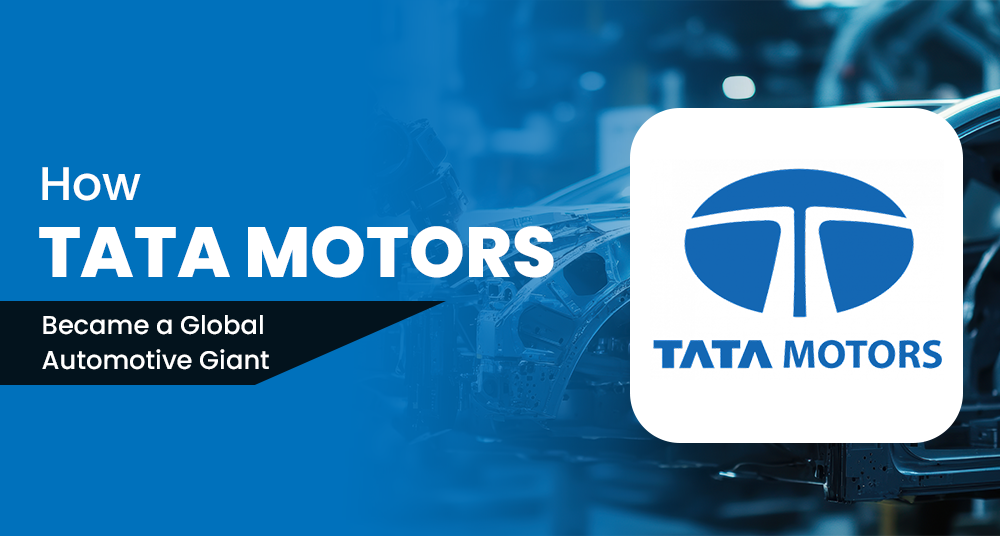Tata Motors is one of India’s most respected automobile manufacturers and a globally recognized automotive giant. From its modest start as TELCO (Tata Engineering and Locomotive Company), which was primarily engaged in locomotives and commercial vehicles, the company has transformed into a multinational automotive powerhouse with a strong presence in commercial vehicles, passenger cars, electric mobility, and luxury brands.
This journey — spanning more than seven decades — is a fascinating narrative of vision, resilience, innovation, and global ambition. Today, Tata Motors is not only India’s leading automobile company but also a symbol of how an Indian brand can stand tall in the global automotive arena.
Early Beginnings: Birth of TELCO (1945)
The story begins in 1945, when the Tata Group, already renowned for steel and heavy industries, established Tata Engineering and Locomotive Company (TELCO). At the time, the company was focused on manufacturing locomotives and heavy engineering products.
In 1954, TELCO entered into a strategic partnership with Daimler-Benz of Germany to produce India’s first indigenously made trucks. This collaboration marked the company’s entry into the automotive sector and laid the groundwork for its reputation in engineering excellence. The rugged, durable trucks quickly became the backbone of Indian logistics and transport.
Growth in Commercial Vehicles
Throughout the 1960s and 70s, TELCO rapidly expanded its presence in the commercial vehicle segment. It launched trucks, buses, and defense vehicles that became integral to India’s economy and infrastructure.
New manufacturing facilities were set up in Jamshedpur, Pune, and Lucknow, allowing the company to scale production. By the 1980s, TELCO had firmly established itself as India’s leading commercial vehicle manufacturer, with its trucks and buses known for durability and cost-effectiveness.
Rebranding as Tata Motors (2003)
As India liberalized its economy in the 1990s, TELCO diversified into passenger vehicles. By the early 2000s, the company realized it was no longer just about engineering and locomotives but about being a holistic automobile manufacturer.
In 2003, TELCO officially rebranded itself as Tata Motors Limited. This was more than just a name change — it reflected the company’s new vision to become a global automotive player, with a diverse portfolio spanning passenger cars, SUVs, trucks, and luxury vehicles.
Entry into Passenger Cars
The 1990s were a bold new chapter for Tata Motors. The company launched its first passenger vehicle, the Tata Sierra, in 1991 — India’s first indigenously developed SUV. Although not a commercial success, it was an indicator of Tata’s ambitions.
This was followed by the Tata Estate (station wagon) and the Tata Sumo (utility vehicle), which gained popularity for their practicality and ruggedness.
The real game-changer came in 1998 with the Tata Indica, India’s first fully indigenous passenger car. Despite skepticism, the Indica became a bestseller and established Tata Motors as a credible player in the passenger vehicle market.
Innovation and the Tata Nano
Perhaps the boldest move in Tata Motors’ history was the launch of the Tata Nano in 2008. Envisioned by Ratan Tata as the world’s cheapest car, priced at just ₹1 lakh, the Nano was aimed at making car ownership accessible to millions of Indian families.
While the Nano gained international fame for its affordability and innovation, it struggled with market perception and safety concerns. Despite its eventual discontinuation, the Nano remains a powerful example of Tata’s spirit of innovation and inclusivity.
Global Expansion: Acquisitions and Partnerships
Tata Motors’ global ambitions took shape in the 2000s through strategic acquisitions and partnerships.
1. Acquisition of Daewoo Commercial Vehicle Company (2004)
In 2004, Tata Motors acquired Daewoo Commercial Vehicle Company of South Korea, gaining access to advanced truck technology and a stronger foothold in international markets.
2. Acquisition of Jaguar Land Rover (2008)
In one of the most iconic moves, Tata Motors acquired Jaguar Land Rover (JLR) from Ford in 2008. Though met with skepticism, Tata successfully turned JLR into a profitable venture, elevating its global reputation and significantly boosting revenues.
3. International Footprint
Tata Motors also established manufacturing and assembly operations in countries like South Africa, Thailand, and the UK, while exporting to over 125 countries, thus solidifying its status as a global auto giant.
Challenges Along the Way
Tata Motors’ journey has not been free of hurdles:
- Global Recession (2008–09): Soon after acquiring JLR, Tata faced the global financial crisis. However, prudent management and strong product launches helped JLR rebound.
- Nano’s Market Struggles: Despite innovation, the Nano failed commercially due to safety perception and marketing challenges.
- Domestic Competition: Rivals like Maruti Suzuki, Hyundai, and foreign carmakers posed stiff competition in India’s passenger vehicle market.
- EV Transition: The automotive industry’s global shift toward electric vehicles required Tata to invest heavily in R&D.
The Electric Revolution
Tata Motors is now leading India’s electric mobility revolution. With the Nexon EV launched in 2020, Tata became India’s top-selling EV manufacturer. Models like the Tigor EV and upcoming EVs are strengthening this position.
The company is supported by the Tata ecosystem — Tata Power (EV charging), Tata Chemicals (batteries), and Tata Autocomp (components) — making it a pioneer in creating a complete EV ecosystem.
Commitment to Sustainability
Sustainability is at the core of Tata Motors’ long-term vision. The company focuses on:
- Reducing emissions and adopting green technologies.
- Designing fuel-efficient and hybrid vehicles.
- Investing in renewable energy and clean manufacturing.
- Supporting recycling and circular economy models.
This aligns Tata with global trends and strengthens its leadership role in the transition to sustainable mobility.
Tata Motors and Commercial Vehicles
Despite global expansion and passenger cars, Tata Motors continues to dominate the commercial vehicle market. From the small Tata Ace (nicknamed Chhota Hathi) to massive heavy-duty trucks, Tata has products across categories.
Its buses, trucks, and defense vehicles remain crucial to India’s infrastructure and economy, ensuring Tata retains its position as a trusted commercial vehicle leader.
Key Milestones
- 1945: Founded as TELCO.
- 1954: Partnership with Daimler-Benz for truck manufacturing.
- 1991: Launch of Tata Sierra, first indigenous SUV.
- 1998: Launch of Tata Indica, India’s first indigenous car.
- 2003: Rebranded as Tata Motors.
- 2004: Acquisition of Daewoo Commercial Vehicle Company.
- 2008: Launch of Tata Nano and acquisition of Jaguar Land Rover.
- 2016: Launch of Tiago, reflecting new design philosophy.
- 2020: Launch of Nexon EV, India’s bestselling electric car.
New Era of Design and Safety
Tata Motors has reinvented its design philosophy with the Impact Design Language, bringing style, comfort, and modern appeal to its cars. Vehicles like the Tiago, Altroz, Harrier, and Safari have helped Tata regain strong footing in the passenger car segment.
Importantly, Tata has earned a reputation for 5-star Global NCAP safety ratings, positioning its cars among the safest in India — a major competitive advantage.
Defense and Special Vehicles
Beyond passenger and commercial segments, Tata Motors is a trusted supplier of defense vehicles to the Indian Army. From troop carriers to armored vehicles, Tata supports India’s defense mobility with indigenous solutions.
Tata Motors Today
Today, Tata Motors stands as:
- A Fortune 500 company.
- Owner of Jaguar Land Rover, a global luxury brand.
- A leader in electric mobility in India.
- A dominant force in commercial vehicles.
- A brand with a presence in over 125 countries.
Its diverse portfolio — from budget-friendly cars to luxury vehicles, from small pickups to heavy trucks, from combustion engines to EVs — showcases unmatched versatility.
Role of Visionary Leadership
Leadership has been central to Tata Motors’ journey. From J.R.D. Tata’s industrial vision to Ratan Tata’s daring decisions (Indica, Nano, JLR acquisition), and now under N. Chandrasekaran’s focus on technology and sustainability, Tata Motors has consistently benefited from strong strategic direction.
Final Thoughts
The story of Tata Motors is more than just about automobiles — it’s about India’s industrial progress, resilience, and global aspirations. From a locomotive manufacturer in 1945 to owning Jaguar Land Rover and leading India’s EV revolution, Tata Motors has come a long way.
Looking ahead, Tata Motors is set to play a key role in shaping the future of sustainable mobility, not just in India but across the globe. Its inspiring journey demonstrates how an Indian company can dream big, innovate constantly, and stand shoulder to shoulder with the world’s biggest automotive brands.
FAQs
1. When was Tata Motors founded?
Tata Motors was founded in 1945 as TELCO (Tata Engineering and Locomotive Company).
2. When was TELCO rebranded as Tata Motors?
The company was rebranded as Tata Motors in 2003.
3. What was Tata’s first passenger car?
The Tata Indica, launched in 1998, was India’s first fully indigenous passenger car.
4. What is Tata Nano known for?
The Tata Nano (2008) was famous as the world’s cheapest car, priced at ₹1 lakh.
5. Who owns Jaguar Land Rover?
Jaguar Land Rover has been owned by Tata Motors since 2008.
6. What is Tata’s bestselling EV?
The Tata Nexon EV is India’s bestselling electric car.
7. Does Tata Motors make defense vehicles?
Yes, Tata supplies troop carriers, armored vehicles, and other defense mobility solutions.
8. What is Tata Motors’ position in commercial vehicles?
Tata Motors is India’s largest manufacturer of trucks and buses.
9. Why is Tata Motors known for safety?
Many Tata cars, such as the Nexon and Altroz, have earned 5-star safety ratings from Global NCAP.
10. What is Tata Motors’ future strategy?
The company aims to lead India’s EV market, expand globally, and continue innovating in sustainability and design.
Related Blog: Tata Group Overview






What do you think?
It is nice to know your opinion. Leave a comment.